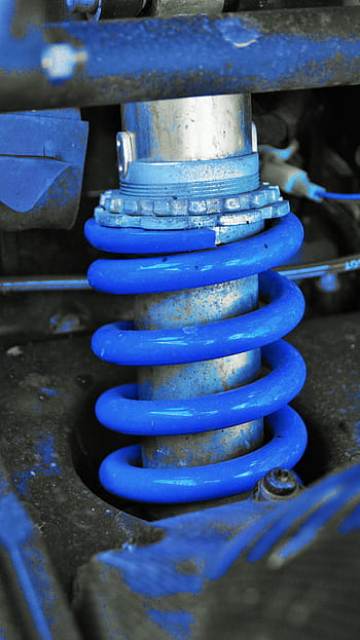Summary
Description and operation of the air suspension
Mounting of the air suspension on the vehicle
Advantages of air suspension
Description of the suspension spring
Function of the suspension spring
Suspension spring maintenance
Air suspension, not to be confused with hydropneumatic suspension (Citroën) uses the principle of gas elasticity: air is compressed to adjust the suspension hardness.
The majority of equipped vehicles (often exclusively in the rear) are commercial vehicles, emergency vehicles (ambulances), 4X4s and motor homes. There are, however, a few passenger vehicles equipped with this system.
The main advantage of air suspension is its ability to change the attitude of the car:
Commercial vehicles: whatever the loading weight, the vehicle’s attitude is the same. When unloading, the vehicle can be lowered to the maximum to facilitate unloading.
Ambulances: the advantage of this suspension is that it is smooth and comfortable, which is essential for transporting people. Here too, the suspension can be lowered for loading the stretcher.
Passenger cars: on MPVs with 8 seats, the air suspension, in addition to its comfort, provides a constant ride height.
4X4: obstacle clearance.
Motor homes: compensation for the vehicle’s heavyweight, levelling for parking, obstacle clearance (large overhang).
Description and operation of the air suspension
Description
The suspension consists of the following elements:
The compressor, which provides the air pressure. It is electric and is often controlled by a computer.
The air springs: these are the ones that receive the air pressure. Their constitution is the same as the air jacks. They advantageously replace springs or blades.
Pneumatic pipes: they ensure the transport of compressed air.
Control and exhaust solenoid valves: they modulate the air pressure for each air spring.
Height sensors: located under the vehicle, they send an electrical signal to the computer that is proportional to the height of the chassis.
Operation
2 operating modes are often possible:
Automatic mode: the computer manages the constant height of the suspensions. It controls the air compressor to raise the ride height and the solenoid valves to lower it, with information on the actual height provided by the height sensors.
Manual mode: a manual control module is installed at the driver’s station, allowing him to adjust the height at will, and for certain applications to control the proper height on each side (motor home).
Mounting the air suspension on the vehicle

The adapter kit is easily available in shops (or even at the accessory shops of commercial vehicles and motor homes). It is relatively easy to install for any enlightened handyman (it is better to have it fitted by a professional for the others).
Here are a few recommendations:
Scrupulously follow the indications contained in the kit.
Carry out the assembly with care, especially for:
electrical and pneumatic connections;
the routing of cables and pipes under the vehicle: it must be carried out with great care (fixings – taking into account the clearance and proximity of the exhaust line for example);
Tightening must be carried out to the prescribed torque;
the safety instructions for working under the vehicle must be observed with the carjacks.
Budget: depending on the options you take, the kits are negotiated between $500 and $1000.
Advantages of an air suspension
The cost aside, you will gain after installation in safety, handling, comfort, reduced suspension travel noise, constant ride attitude whatever the load (no more problems with headlights too high, no more large suspension travel), possibility to manually adjust the height (to unload, to pass an obstacle…).
Finally, all these advantages will result in more efficiency at the wheel, less fatigue and lower fuel consumption.
Now, let’s have a look at the suspension springs.
Description of the suspension spring

It provides the link between the chassis and its suspended components and the elements of the non-suspended running gears (all the components that directly absorb the shocks due to contact with the road: wheels, hubs, brakes, ball joints).
It is helical in shape, made of hardened steel, formed of several turns (open loop that announces or initiates a spiral movement), which makes its movement elastic. Its oscillations progressively dissipate the energy accumulated by the shocks in the wheels. It works in conjunction with a shock absorber that limits its oscillations.
Note: the suspension spring is not the only one involved in filtering road shocks. The tyre is also part of the suspension because of its elasticity.
The function of the suspension spring

It absorbs road irregularities with the aim of:
Keep the wheels in contact with the ground and thus allow good road holding;
Filter the shocks resulting from the deformation and roughness of the road to:
ensure an acceptable comfort for the passengers of the vehicle;
protect the mechanical components and the vehicle body from these shocks.
Suspension spring maintenance
The suspension spring is checked visually:
it can be strongly corroded by projections (example: salt in winter);
it can lose its elasticity and sag;
finally, it is likely to break at the level of the coils.
The maintenance of the suspension spring is very reduced. In the event of mud accumulation, it is only necessary to clean it with a high-pressure cleaner.
Caution: Using the cleaner on the front springs can cause water and sand to get into the swivel bearings (bearings) and thus hinder the rotation of the spring when turning.
When replacing the springs, the springs should be replaced in pairs (on the same train). A special tool called a “spring compressor” should only be used by a professional.

